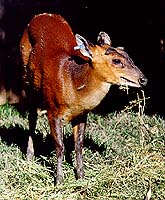
The cervids include deer and their allies, including familiar moose, elk, and caribou. Member of this family occupy a wide range of habitats, from arctic tundras to tropical forests, and native species of cervids can be found over most of the world except Africa south of the Sahara, Australia, and Antarctica. They have also been introduced to a number of areas that originally had no cervids. Currently, we recognize around 44 species of living cervids, placed in 17 genera, including a new genus and species (Megamuntiacus vuquangensis) recently discovered in the Annamite Mountains of southeastern Asia. Deer are sometimes divided into four subfamilies. Some taxonomists include the genus Moschus (musk deer) within the Cervidae, but here we follow recent authorities and place it in its own family, the Moschidae.
Cervids range in body size from the very small Andean Pudu (around 10 kg) to the very large moose of North America and Europe (800 kg). Some are stocky, others are slender and gracile in body shape. All have slender legs. Most are brown or gray in color, and the young of most species are spotted with white. In a few species, the adults are also spotted.
Antlers are found in all genera of cervids but one. These structures are made of bone. They arise from a permanent bony base on the frontals called a pedicel. In temperate-zone cervids, the antlers begin growing in the spring as skin-covered projections from the pedicels. The dermal covering, or "velvet," is rich in blood vessels and nerves. When the antlers reach full size, the velvet dies and is rubbed off as the animal thrashes its antlers against vegetation. The antlers are used in combat by males during the breeding season, and drop off afterwards. They vary from simple spikes to enormous, complexly branched structures, depending on the species and age of the individual bearing them. In most cervids, only males have antlers (but both sexes bear them in caribou). Curiously, the few species that lack antlers or that have small antlers usually have enlarged, sabre-like upper canines.
Their cheek teeth of cervids are selenodont but not usually as high-crowned (hypsodont) as the teeth of the bovids. Upper incisors are absent; in the lower jaw, three incisors are present on each side of the jaw and are joined by an incisor-like canine. Deer clip vegetation by pinching it between their lower incisors and the tough pad on their palate. The dental formula is 0/3, 0-1/1, 3/3, 3/3 = 32 - 34.
Other traits of cervids include a vacuity (gap or opening) between the nasal, frontal and the lacrimal; lacrimal duct with two openings; presence of a postorbital bar; and absence of a sagittal crest. They have 4 toes on each foot, but the lateral toes are small and usually do not contact the ground. The third and fourth metacarpals (front limbs) and metatarsals (hind limbs) are fused to form an elongated cannon bone (a condition also seen in antilocaprids and bovids). Weight is born on digits three and four (that is, they are paraxonic), which are hooved. The tarsals are reduced in number to five bones (calcaneus, astragalus, fused navicular and cuboid, fused ectocuneiform and mesocuneiform, and internal cuneiform)
Cervids have a four chambered stomach. They ruminate ("chew their cud") and use bacterial fermentation to help digest their food.
Some cervids are solitary but most live in herds that vary from a few individuals to many (depending on species, sex, and age). Most species are polygynous, and the males use their antlers in combat to obtain and defend females. Males are usually larger than females, and sexual dimorphism is most pronounced in the most highly polygynous species. Deer have a number of glands on their feet, legs, and faces; these are used in intraspecific communication.
Most species are browsers, but some include a substantial proportion of graze in their diets.
Cervids first appear in the late Oligocene. Some Pleistocene cervids had spectacular antlers; these include the "Irish elk" Megaloceros, which was not an elk and was not restricted to Ireland. Megaloceros had large palmate antlers with a span up to 3.7 m and a weight around 45 kg. Another extinct deer with spectacular antlers was Eucladoceros, a large animal whose antlers were made up of many of irregularly branched tines.
Deer have considerable economic importance around the world. They are hunted for sport, for meat, and for their hides. Reindeer are important domestic animals in the far north. Several species have nearly been extirpated. A few others have been introduced far outside their natural ranges, often to the detriment of native species.
 caribou |
 elk |
 moose |
 muntjac |
Family Suidae Family Tayassuidae Family Hippopotamidae Family Camelidae Family Tragulidae Family Giraffidae Family Moschidae Family Cervidae Family Antilocapridae Family Bovidae<<<<<<<>>>>>>> ARTIODACTYLA CARNIVORA CETACEA CHIROPTERA DASYUROMORPHIA DERMOPTERA DIDELPHIMORPHI DIPROTODONTIA HYRACOIDEA INSECTIVORA LAGOMORPHA MACROSCELIDEA MICROBIOTHERIA MONOTREMATA NOTORYCTEMORPHIA PAUCITUBERCULATA PERAMELEMORPHIA PERISSODACTYLA PHOLIDOTA PRIMATES PROBOSCIDEA RODENTIA SCANDENTIA SIRENIA TUBULIDENTATA XENARTHRA
Email: eradani7@aol.com